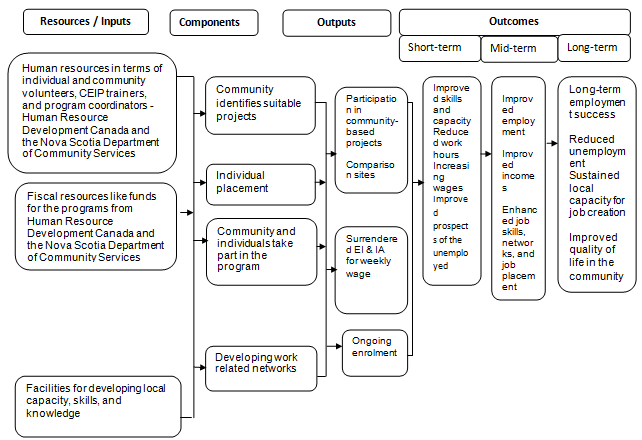Description of the logic model process
The CEIP needs to address unemployment in communities around Cape Breton Island in Nova Scotia. The need for the CEIP is to develop the local capacity, initiate community-based employment, develop new skills, enhance job placement, and work-related contacts with a long-term goal of improving employment success and reducing unemployment.
The CEIP targets community and individuals for a membership of 1,500 participants. Both community and individuals will take action to participate in identifying viable projects at the community level.

Participants are mainly volunteers who receive fiscal support and other supports from Human Resource Development Canada and the Nova Scotia Department of Community Services.
These activities will lead to ambitious and long-term outcomes, such as building local capacity, enhancing employment prospects, reducing unemployment and long work hours, and improving quality of life.
The short-term and mid-term outcomes will ensure that the community and individuals realize immediate benefits and associated outcomes of the program. All stakeholders must work together throughout various stages in order to realize these benefits (McDavid, Huse and Hawthorn, 2013).
The program activities included training alongside assessment of aptitudes, experiences, education, and skills. It also included skill development, funding, and capacity building, surrendering EI and IA for community wage, identifying suitable community-based projects, recruiting 1,500 volunteers, and developing work-related networks.
The program outputs included all completed activities. These are tangible deliverables because of activities. The CEIP activities of engaging 1,500 volunteers and community members, funding, and surrendering EI and IA have corresponding outputs on the number of community-based projects identified, participation, ongoing enrolment, comparison sites, and the number of volunteers who surrender EI and IA for community wages.
The program inputs or resources included human resources in terms of individuals and community volunteers, CEIP trainers, and program coordinators. There were fiscal resources for the program from the Human Resource Development Canada and the Nova Scotia Department of Community Services and facilities for developing local capacity, skills, and knowledge.
The CEIP is an ongoing program that started in 1999. Today, it is in the evaluation stage. The stage would show the realized program outcomes and any factors, which have facilitated or hindered the realization of these outcomes.
The program contextual factors are the beliefs that communities and individuals know their challenges and can develop the best methods to solve them. At the same time, the focus on reducing employment and long-term employment success are the mainframe contexts that drive CEIP.
Reference
McDavid, J. C., Huse, I., and Hawthorn, L. R. L. (2013). Program Evaluation and Performance Measurement: An Introduction to Practice. Thousand Oaks: Sage Publications, Inc.